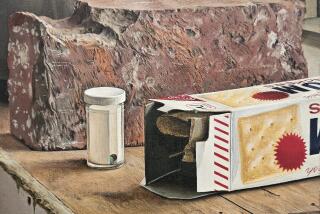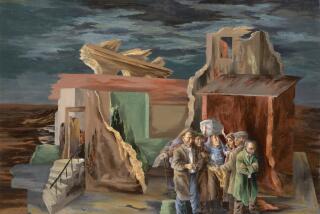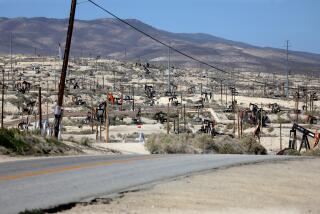Like Fine Art, Price’s Career Grows in Value
- Share via
In the 50th year of his film career--he began in 1938 with “Service de Luxe” with Constance Bennett and Charles Ruggles--Vincent Price is still hard at it, being artful, elegant and amusing.
He plays a courtly and charming White Russian exile, living on memories, the last of the family jewels and the kindness of widow ladies, in “The Whales of August.” In “The Offspring,” a horror film made in Georgia with verve and little money by some recent USC graduates, Price is the storytelling host in an uncommonly grisly small Southern town.
His huge success in the ‘50s and ‘60s shockers like “House of Wax” and Roger Corman’s “The Pit and the Pendulum” and other Poe stories brought Price a continuing worldwide following.
The triumphs in genre films obscured the larger range of his gifts as an actor, but longevity is now righting the balance. He had begun, conspicuously, playing Prince Albert to Helen Hayes’ Queen Victoria in “Victoria Regina.”
He has also played everyone from Sir Walter Raleigh (with Bette Davis and Errol Flynn in “Elizabeth and Essex”) to Cardinal Richelieu to Joseph Smith of the Mormons (in “Brigham Young--Frontiersman” in 1940).
Recently Price has been most widely seen as the urbane and enthusiastic host of the PBS series “Mystery,” which has been presenting Agatha Christie, P. D. James (“The Dark Tower” is next) and Dorothy L. Sayers, with Edward Petherbridge as a well-nigh-perfect Lord Peter Wimsey.
Price earned his credentials as the “Mystery” host. He loves them. “I’ve been a lecturer,” Price remarked in his art-filled house in the Hollywood Hills the other afternoon. “Hours on trains, planes and buses, so I read mysteries all the time.
“When I was touring ‘Don Juan in Hell’ with Charles Boyer, Sir Cedric Hardwicke and Agnes Moorehead, Charles wouldn’t fly so we traveled by bus. We bought paper bags full of paperback mysteries and thrillers. We made a pact. If the girl hadn’t been seduced or there hadn’t been a murder by page 30, out it went. Cedric and Charles were men of great dignity, but they were seen throwing paperbacks out the windows of the bus. We must have gone through four or five hundred.”
Price had more time for mystery reading when he toured his one-man show as Oscar Wilde, “Diversions and Delights,” created by John Gay around the inventive premise that Wilde was staging a fund-raiser for himself and trotting out all his best material.
“I did it more than 800 times, everywhere, including Australia, New Zealand and Hong Kong,” Price says. “After two years in the big cities here, I took it to college towns, a bit worried whether young students would take to Wilde. But at the first campus, a small college in Michigan, the show ran 10 minutes long, thanks to the laughter. The audience got everything.”
One of Price’s favorite Wilde retorts occurred when Wilde himself was on a lecture tour of the United States, during which he visited Niagara Falls and was told it was much favored by honeymooners. “It must be the second greatest disappointment in American married life,” Wilde said haughtily.
There were plans to tape the show, but they fell through over the matter of permissions from the Wilde estate, and now, Price thinks, it is too late. “You have to do it while you’re in it.”
Price, who studied art history at Yale and took a master’s degree in the subject in London, has been an indefatigable promoter of fine art. For a time in the 1940s he had his own gallery in Beverly Hills.
“I rented a hole in the wall no bigger than this living room next door to Martindale’s bookshop for $75 a month.” (This was a very long time ago.) “One day Igor Stravinsky, whom I knew, came in and said he was meeting some friends for breakfast at the deli next door and could he wait in the shop. He liked me because he said I was the only man he knew who was tall enough to dance with his wife Vera, who was very tall.
“As we were talking, the novelist Franz Werfel came in. I was doing ‘The Song of Bernadette,’ which was based on his book, and I was very impressed. Then Aldous Huxley came in. Then Thomas Mann. Then Arnold Schoenberg and Sergei Rachmaninoff. I said, ‘I’ve got to get out of here; this is too high-powered for me.’ Then they all went next door for their lox and bagels or whatever it was. They all lived here then. It was quite a time.”
Price was remembering that he attended Andrew Wyeth’s first show and bought a watercolor for $75. “I gave it as a wedding present 10 years later. Never should have,” Price said, shaking his head. Wyeth also remembered Price’s early patronage and, when Price was organizing a mammoth art-selling program for Sears, called Price and asked to be included.
“He said that his work had become so famous that he could now sell a painting before he’d even painted it. He didn’t like it because he felt no one was seeing his paintings anymore. Our talk led to the largest single-item sale ever made at Sears in Buena Park--a Wyeth that went I think for $25,000.”
Price and some other collectors (Fanny Brice, Edward G. Robinson, the agent Sam Jaffe and his wife and a few others) founded the Modern Institute of Art, hoping to raise the local consciousness about contemporary art.
“Very particularly,” Price says, “we hoped to convince Walter Arensberg to leave his fabulous collection of modern art to Los Angeles. If Los Angeles could have gotten it, it would have made the city a major center for contemporary art.”
But it was evidently too early by several decades for Los Angeles. Arensberg gave his collection to Philadelphia. The art Price and the others had donated to the institute became the nucleus of the UCLA collection.
There is a gallery named for Price at East Los Angeles College, where he started an art program 35 years ago with a donation of several hundred pieces of art. “I’m so pleased,” Price says. “They’re doing wonderful shows and turning out terrific people. A young woman from the school is now at the Getty. From the ghetto to the Getty. Wonderful.”
Price’s forte as a collector has been Old Master drawings. What he regrets is that it is becoming prohibitively expensive to become or remain a collector. “I came across an old catalogue from a Boston dealer in prints. You could get a good Rembrandt drawing for $750. Now even the lesser ones are $10,000, even if you can find one. For young people, even lithographs are very expensive these days.”
Price is pleased that “The Whales of August,” in which he co-stars with Lillian Gish, Bette Davis and Ann Sothern, is off to a good start. The making of it, on an austerely beautiful island off the coast of Maine, was difficult. “We called it ‘The Whales of October’ it was so cold.
“People say it’s slow, which it is. But they like it, and they say it’s a kind of picture that will never be made again. Hmmm. I don’t know if that’s a compliment or not.”
It is.
More to Read
Only good movies
Get the Indie Focus newsletter, Mark Olsen's weekly guide to the world of cinema.
You may occasionally receive promotional content from the Los Angeles Times.










